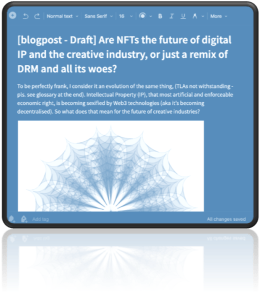Are NFTs the future of digital IP and the creative world, or just a remix of DRM and all its woes? (Part 2)
This is second in a series of posts I drafted to share some observations, opinions and conclusions from playing with this intriguing technology that sits squarely at the intersection of: creative content, digital tech and intellectual property. The topic is broken down into the following parts:
- What are NFTs (and the non-fungibility superpower)?
- What has this got to do with Intellectual Property (and content protection)?
- Does it mean that NFTs are like DRM remixed?
- How does it affect the creative industry today and in the future?
- Summary observations and conclusions.
In the first post, we discussed how non-fungibility, blockchain provenance and smart-contract based royalty payments have conferred a certain superpower to NFTs. This now begs the second question…
2 – What has this got to do with Intellectual Property (and digital content protection)?
Well a little history lesson might be in order, just to set the right context, as follows:
- First came analog content and copyright – The Statute of Anne (1710), is widely regarded as the world’s first copyright law, and it helped protect the rights of authors versus traditional booksellers, (many of whom sought those rights in perpetuity), and one of the more disruptive tech innovation of the day, i.e. the printing press. Similar IP rights for other content and media forms were not far behind, e.g.: for performance, music, and photography, or basically anything that can be reproduced and distributed with some (usually newer) technology.
- Then came digital content and Internet piracy – Computers, the Internet, and file sharing applications such as Napster, Torrents and media streaming platforms, all made it progressively easier to create, reproduce and distribute digitalised content with or without permission. In turn, this led to the introduction of various digital content protection mechanisms, such as: watermarking, fingerprinting, steganography and Digital Rights Management (DRM) solutions.
- Now comes trusted ledger and decentralisation – New blockchain ledger technology enable users to establish and track ownership, provenance, and to engage in “trustless” transactions of digital goods, services and cryptocurrency on the internet. The emergence of NFTs have taken this a step further by establishing a certain “uniqueness” attribute in a medium notorious for its built-in capability to create, copy and share perfect copies of any digital work. In addition, it provides a means to programmatically enforce the economic rewards (aka royalties) due the original author / owner from downstream sales of her work, in perpetuity!
In conclusion, you’d be right to say that Intellectual Property, such as copyright, is a totally artificial construct squarely aimed at providing economic reward and incentive for the creation of otherwise intangible works of the mind. NFTs provide a means to realise that promise via smart contracts.
However, you might also observe a link between intellectual property, commerce and the evolution of yet more sophisticated technology for creating, reproducing and distributing content. Of course, the use and output from these technologies are subject in turn to the same intellectual property rights / law that they sometimes challenge. As a result, over the years, this has led to numerous conflicts between individuals, organisations and even nations. Blockchain and NFTs will be no different, so buckle up for the ride!
In part 3, we’ll examine if and how NFTs are similar, or not, to DRM.
Disclaimer: The opinions expressed in this post are mine alone, and do not reflect those of my employer or professional affiliations in any way, shape or form. Secondly, it does not constitute any legal, financial, spiritual or otherwise professional advice, and I do not claim any specific expertise on these topics. Furthermore, I believe, we’re still very early into these particular digital technologies and their fast emerging use cases, therefore it is always advisable to proceed with caution.
Pls. Note: As part of my education, research, and experimentation, I purchased a couple of NFTs and even minted a few pieces on OpenSea, (the above NFT image is based on an early draft of this article). It is used here for illustration and critique purposes only.
-
February 5, 2022 at 3:26 pmAre NFTs the future of digital IP and the creative world, or just a remix of DRM and all its woes? (Part 1) | Judeumeh's Blog
-
February 5, 2022 at 4:28 pmAre NFTs the future of digital IP and the creative world, or just a remix of DRM and all its woes? (Part 3) | Judeumeh's Blog
-
February 6, 2022 at 11:42 pmAre NFTs the future of digital IP and the creative world, or just a remix of DRM and all its woes? (Part 4) | Judeumeh's Blog
-
February 15, 2022 at 1:27 pmAre NFTs the future of digital IP and the creative world, or just a remix of DRM and all its woes? (Part 5) | Judeumeh's Blog
